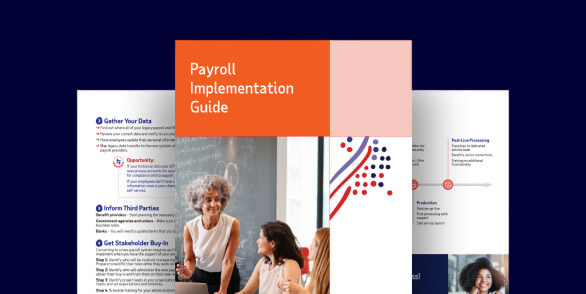insight
What is a payroll service provider?
Looking for an easier way to run payroll?
A payroll service provider is a company that either assists with or assumes all aspects of payroll on behalf of another business. This arrangement is often beneficial for employers who value their time and want to ensure that their employees and taxes are paid accurately and on schedule. In some cases, business owners may also save money when they consider that a payroll service provider can help them eliminate expensive tax penalties.
Table of Contents
What do payroll providers do?
Payroll service providers generally deliver more than just basic payroll calculations. Most use technology to minimize laborious, administrative tasks for employers and create engaging experiences for employees. Some core capabilities of payroll providers include:
Automatic payroll processing
The time spent calculating wages and paying employees is greatly reduced when the process is automatic. Flexible payment options – paycheck, direct deposit or paycard – may be available.
Tax withholding and wage garnishment
Automated payroll systems ensure that all appropriate taxes, garnishments and other payroll deductions are withheld from employee wages accurately and paid on time.
Tax filing services
Some full-service payroll providers will take care of filing federal, state and local taxes on behalf of their clients. They may also assist with year-end reporting and prepare Forms W-2, 1099-NEC, etc.
Compliance expertise
Payroll providers typically keep up with regulatory changes and may notify their clients about changes to wage and tax laws that affect their business. What’s more, some cloud-based payroll systems have real-time compliance updates.
Payroll reporting
Employers typically can run detailed reports covering all areas of their payroll operations – wages paid, taxes withheld and hours worked, among other details.
Employee self-service
Self-service options empower employees to review their pay statements, update their withholdings or change their personal information without the need for managerial assistance.
Product support
Most reputable payroll providers have expert specialists available to answer client questions promptly. In some cases, support is available 24/7 via phone or online chat.

On the search for a payroll service provider?
ADP’s comprehensive, intuitive payroll solutions help ensure accuracy, efficiency and compliance.
Integrating payroll with other software and business processes
There are many moving parts to payroll and nothing helps them work in sync like partnering with a payroll service provider. By integrating related functions, employers can eliminate duplicate data entry, save time and reduce errors. Payroll is generally compatible with the following software and business processes:
Benefits
Health insurance premiums and retirement plan contributions can be deducted via the payroll system.
Human resources
New or revised policies that affect payroll may update in real-time to help support compliance.
Workers' compensation
Premium payments can sometimes be made based on actual payroll numbers and not estimates.
Time tracking and attendance
Wage calculations are generally more reliable when time and attendance data flows directly from the source to payroll.
Expenses and budgeting
Integrations with accounting software can show much total revenue is dedicated to payroll.
Point of sale (POS) devices
Employers may be able to track payroll costs versus the sale of goods or services.
Job costing
Managers can see which jobs are most profitable for the business relative to payroll.
Business management
Businesses that use workflows can track payroll costs for specific projects.
How do employers choose a payroll provider?
Before committing to a payroll service, it’s essential for employers to make sure the provider offers all the services they need. Here are some steps to guide the decision-making process:
1. Make a list of current payroll challenges
Some employers struggle with tax compliance, while others have trouble performing the necessary calculations or simply don’t have enough time for payroll.
2. Confirm compatibility
Business owners who are managing payroll with accounting software may want to inquire if a provider is capable of integrating with their particular program to ensure a seamless transfer of data.
3. Ask about customer support
When payroll issues arise, it shouldn’t take days to receive an answer or solution. Look for providers that offer dependable support services.
4. Determine how much time can be saved
Compared to manual processes, payroll providers save considerable time, but just how much depends on the level of control desired by the employer.
5. Find out when the transition can begin
Employers who are in desperate need of payroll support may want a provider who can start at any time, as opposed to one that can only start at the beginning of a new quarter or new year.
6. Get cost estimates
Pricing structures vary, but most providers should be able to provide a cost estimate based on the number of employees and the frequency of payroll.
7. Research vendor reputation
Customer reviews and independent analyst reports can be helpful when trying to decide between two providers who are equal in all other aspects.
Explore Download the guidebook: “Choosing the Right Payroll Provider for Your Business”
Switching payroll providers
Even with due diligence and a thorough evaluation of the payroll services on the market, it’s possible to make a wrong decision. Employers who are still spending too much time on payroll or are unhappy with the level of support they’re receiving may want to consider switching providers. The good news is that it’s possible to make a change with minimal interruption to existing operations.
When is the best time to change to a different payroll service?
Many employers believe that it’s easiest to switch payroll providers at the start of a new year, but this is not always the case. Some of the more reputable payroll providers can accommodate conversions at any time of the year without diverting excessive time or resources from essential business functions.
Payroll service transition checklist
Once a contract is signed, the new payroll provider’s implementation team will typically provide guidance on the transition and setup process. The following checklist provides an overview of what employers can expect during this time:
1. Preparation of payroll data
Detailed information must be provided about all employees, payroll, taxes and the business itself. Examples of some of the necessary documentation includes Form W-4 withholding certificates, current year Form 941 payroll filings and employer tax ID numbers.
2. Tax history verification
New payroll providers usually check the tax history from the previous quarter for any errors that need correction and may pay any taxes owed on behalf of the client.
3. Payroll verification
Prior to the first live payroll, the new provider may conduct a digital onboarding process, during which the client reviews all bank, employee and tax information for accuracy.
4. Cancellation of old payroll and tax services
After the new provider successfully runs the first payroll, employers can close out their contract with the old payroll provider and any separate entities that paid taxes on their behalf to avoid double payment.

Switch to ADP today
Sign up for ADP’s small business payroll solutions to get the expertise and easy-to-use tools that simplify payroll.
Frequently asked questions about payroll service providers
What are some types of payroll providers?
When it comes to processing payroll, business owners have the following types of providers to choose from:
Payroll software provider
Online software automates payroll, which simplifies calculations and produces more accurate results. Depending on the package, taxes and compliance may still be the responsibility of the business owner.
Full-service payroll provider
This option affords employers the most value in terms of time and peace of mind since the provider handles all aspects of payroll on the client’s behalf.
Accountant
Employers who enlist the aid of an accountant usually get trusted advice on the local tax regulations specific to their business. However, counsel may not be available 24/7, especially during tax season.
Professional employer organization (PEO)
Co-employment arrangements typically include full-service payroll, plus the added bonus of compliance monitoring, HR support, competitive benefits packages and more.
Do payroll service providers offer mobile applications?
Yes, many payroll services are equipped with mobile capabilities so employers can run payroll, create and manage timesheets, or check tax payments from any device, at any time. Self-service applications are also typically mobile friendly, which allows employees to check their pay statements, update personal information or manage withholdings while on the go.
What is the average cost of a payroll service?
The average cost of a payroll provider varies based on business size, payroll frequency and the number of services required. In most cases, there is a monthly base fee, plus a per employee processing fee. ADP works with clients to determine the right package for their business, no matter how simple or complex their needs are.
Do payroll providers offer tax penalty protection?
Some payroll providers offer compliance monitoring services that can help protect employers against expensive tax violations. Additionally, if a provider pays taxes on behalf of the client, it may offer a guarantee that the taxes will be done right or it will pay to correct the errors.
Want ADP’s payroll expertise on your side?
Pay your people faster and easier than ever before. Have taxes automatically calculated, deducted, and paid for you, and avoid costly mistakes before they happen.
Want more exclusive business insights like this delivered to your inbox?Subscribe now
This guide is intended to be used as a starting point in analyzing how to do a payroll and is not a comprehensive resource of requirements. It offers practical information concerning the subject matter and is provided with the understanding that ADP is not rendering legal or tax guidance or other professional services. Please consult with your legal counsel.
1. ZipRecruiter is a registered trademark of ZipRecruiter, Inc.
2. Legal services are provided by Upnetic Legal Services, a third-party provider





